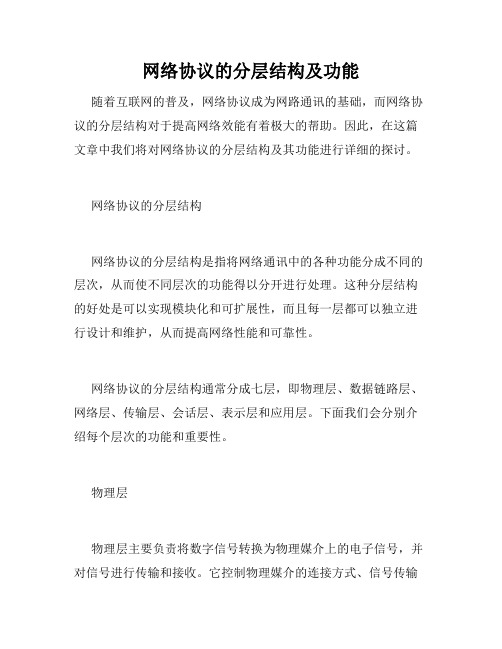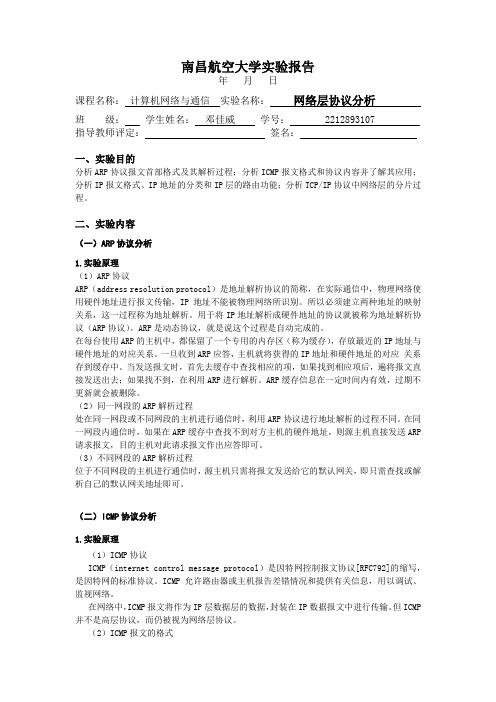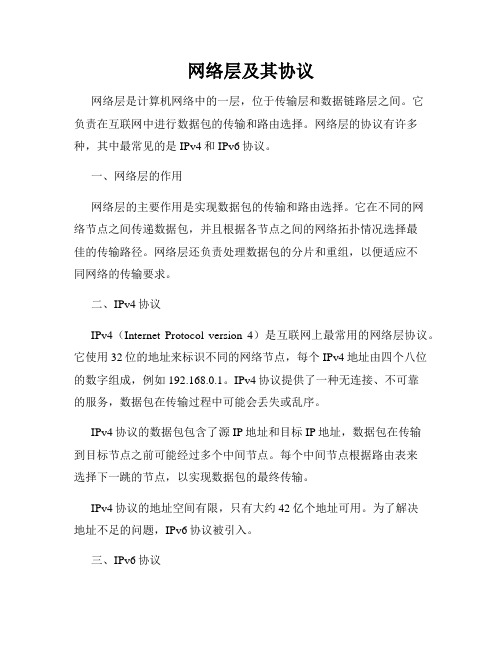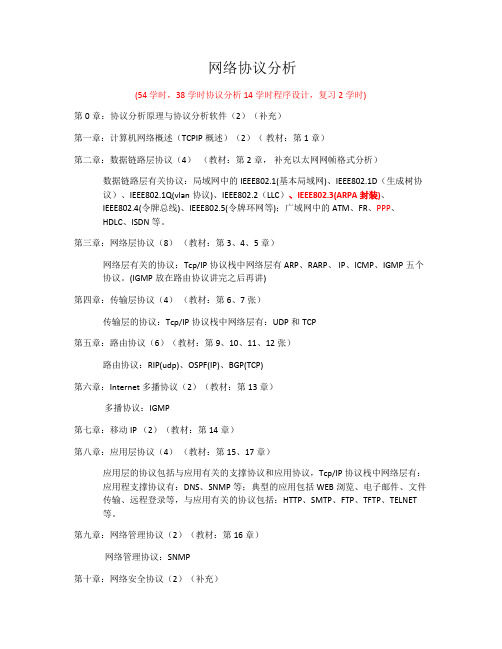第五章 网络层协议分析
网络协议的分层结构及功能

网络协议的分层结构及功能随着互联网的普及,网络协议成为网路通讯的基础,而网络协议的分层结构对于提高网络效能有着极大的帮助。
因此,在这篇文章中我们将对网络协议的分层结构及其功能进行详细的探讨。
网络协议的分层结构网络协议的分层结构是指将网络通讯中的各种功能分成不同的层次,从而使不同层次的功能得以分开进行处理。
这种分层结构的好处是可以实现模块化和可扩展性,而且每一层都可以独立进行设计和维护,从而提高网络性能和可靠性。
网络协议的分层结构通常分成七层,即物理层、数据链路层、网络层、传输层、会话层、表示层和应用层。
下面我们会分别介绍每个层次的功能和重要性。
物理层物理层主要负责将数字信号转换为物理媒介上的电子信号,并对信号进行传输和接收。
它控制物理媒介的连接方式、信号传输速率和数据传输距离,与接线、接头、电信号等有关。
具体来说,物理层的主要任务包括:1. 传输数字信号:将数字信号转换为物理媒介上的电子信号进行传输。
2. 传输数据:将数据通过物理介质传输到远程节点。
3. 控制传输速率:调整数据传输速率,以确保数据的可靠传输。
4. 确定物理连接方式:确定与其他设备之间的物理连接方式,包括电缆、光缆、无线电信道等。
数据链路层数据链路层主要负责将物理层传输的数据转换为数据包,并将数据包传输到目标设备上。
它控制数据包的传输和接收,提供一些控制和监控功能,从而保证数据传输的可靠性。
具体来说,数据链路层的主要任务包括:1. 将数据转换为数据帧:将数据转换为数据帧,以便在物理网络上传输。
2. 控制访问:控制节点在共享的介质上的访问,以避免冲突和竞争。
3. 纠错和控制流量:纠正传输过程中出现的一些错误,并调节流量以避免网络超载。
4. 帧同步:为确保帧能被正确地接收和解析,确保数据帧的同步。
网络层网络层主要负责将数据包从发送端传输到接收端,并处理不同网络之间的路由和转发问题。
它控制数据包的路由、转发和选路,提供流量控制和差错控制的功能。
网络层协议分析实验报告

工程类实验报告系:系: 计算机与信息计算机与信息 专业:专业:专业: 年级:年级:年级: 09 09级 姓名:姓名: 学号:学号:学号:********* 091154048 091154048 实验课程:实验课程:实验课程: 实验室号:实验室号:__田C 513____ C 513____ 实验设备号:实验设备号:实验设备号: 48 48 48 实验时间:实验时间:实验时间: 指导教师签字:指导教师签字: 成绩:成绩:成绩:实验二 网络层协议分析一、 实验目的和要求1.执行ping ping 和和tracert tracert 命令,命令,分析截获的ICMP ICMP 报文类型和报文类型和ICMP ICMP 报文格式,报文格式,理解ICMP ICMP 协议的作用。
协议的作用。
协议的作用。
2. 2. 使用使用使用 Ping Ping Ping 命令在两台计算机之间发送数据报,命令在两台计算机之间发送数据报,用Wireshark Wireshark 截获数据报,截获数据报,分析IP IP 数据报的格式,加深对数据报的格式,加深对IP IP 协议的理解。
协议的理解。
协议的理解。
3. 3. 使用使用Ping Ping 命令在两台计算机之间发送大于命令在两台计算机之间发送大于MTU MTU 的数据报,的数据报,验证分片过程,加深对IP IP 协议的理解。
协议的理解。
协议的理解。
二、实验原理1.ICMP 协议及PINT 和TRACERT 程序程序 2. IP 数据报格式数据报格式 3. IP 分片原理分片原理 三、实验设备与环境1. 实验设备和连接图下图所示,一台锐捷R1760 R1760 路由器连接路由器连接2 2 台台PC PC 机,分别命名为机,分别命名为机,分别命名为PC1PC1、、PC2PC2。
2. 2. 实验分组实验分组实验分组每二名同学为一组,每小组各自独立完成实验。
每二名同学为一组,每小组各自独立完成实验。
网络5层协议

网络5层协议网络5层协议是指网络通信中,将通信过程分为五个层次的协议模型。
这个模型划分了不同的功能,使得网络通信变得高效和可靠。
下面将逐层介绍网络5层协议。
第一层:物理层物理层是网络5层协议中的最底层,它负责将比特流转化为电信号,并通过物理介质进行传输。
物理层的主要作用是提供传输介质、数据编码和物理拓扑等方面的标准。
物理层协议定义了电缆的类型、传输速率和接口标准等。
第二层:数据链路层数据链路层位于网络5层协议的第二层,它负责将物理层传输的比特流划分为数据帧,并进行错误检测和纠正。
数据链路层的功能包括帧同步、流控制和差错控制等。
此外,数据链路层还定义了数据帧中的MAC地址,用于在局域网中唯一标识网络设备。
第三层:网络层网络层是网络5层协议中的第三层,它负责将数据链路层传输的数据包进行路由选择和转发。
网络层的主要任务是实现不同子网之间的数据传输,通过IP地址对数据进行唯一标识和寻址。
此外,网络层还负责数据的分片和重组,以提高网络的效率和可靠性。
第四层:传输层传输层是网络5层协议中的第四层,它主要负责提供可靠的端到端数据传输服务。
传输层使用端口号标识不同的应用程序,并通过传输协议(如TCP或UDP)实现可靠或不可靠的数据传输。
传输层还负责拥塞控制和流量控制,以保证网络的稳定性和高效性。
第五层:应用层应用层是网络5层协议中的最高层,它负责为用户提供网络应用服务。
应用层包括各种应用协议,如HTTP、FTP和DNS等。
应用层协议定义了数据的格式、传输方式和应用逻辑等。
通过应用层,用户可以访问网络资源、发送电子邮件和进行文件传输等操作。
以上是对网络5层协议的简要介绍。
网络通信中,通过这五个层次的协议模型,实现了数据在不同设备之间的传输和交换。
每个层次都有特定的功能和任务,共同协作完成网络通信的目标。
了解网络5层协议对于理解网络通信、网络安全和网络优化等方面都具有重要意义。
网络层协议实验报告(3篇)

第1篇一、实验目的1. 理解网络层协议的基本概念和作用;2. 掌握IP协议、ARP协议和RIP协议的基本原理和配置方法;3. 通过实验验证网络层协议在实际网络中的应用。
二、实验环境1. 实验设备:一台安装有Cisco Packet Tracer软件的PC机;2. 实验软件:Cisco Packet Tracer 7.3.1模拟器;3. 实验拓扑:实验拓扑结构如图1所示,包括三台路由器(R1、R2、R3)和三台主机(H1、H2、H3)。
图1 实验拓扑结构图三、实验内容1. IP协议分析实验(1)实验目的:了解IP协议的基本原理和配置方法。
(2)实验步骤:① 在R1、R2、R3上配置IP地址、子网掩码和默认网关;② 在H1、H2、H3上配置IP地址、子网掩码和默认网关;③ 使用Ping命令测试H1与H2、H3之间的连通性;④ 分析实验结果,验证IP协议在网络层的作用。
(3)实验结果与分析:通过实验,验证了IP协议在网络层中实现数据包的传输和路由功能。
当H1与H2、H3之间进行通信时,数据包会按照IP地址进行路由,最终到达目标主机。
2. ARP协议分析实验(1)实验目的:了解ARP协议的基本原理和配置方法。
(2)实验步骤:① 在R1、R2、R3上配置IP地址、子网掩码和默认网关;② 在H1、H2、H3上配置IP地址、子网掩码和默认网关;③ 在H1上配置MAC地址与IP地址的静态映射;④ 使用Ping命令测试H1与H2、H3之间的连通性;⑤ 分析实验结果,验证ARP协议在网络层的作用。
(3)实验结果与分析:通过实验,验证了ARP协议在网络层中实现IP地址与MAC地址的映射功能。
当H1与H2、H3之间进行通信时,数据包会通过ARP协议获取目标主机的MAC地址,从而实现数据包的传输。
3. RIP协议分析实验(1)实验目的:了解RIP协议的基本原理和配置方法。
(2)实验步骤:① 在R1、R2、R3上配置IP地址、子网掩码和默认网关;② 在R1、R2、R3上配置RIP协议,使其相互通告路由信息;③ 在H1、H2、H3上配置IP地址、子网掩码和默认网关;④ 使用Ping命令测试H1与H2、H3之间的连通性;⑤ 分析实验结果,验证RIP协议在网络层的作用。
计算机网络实验五网络层协议分析实验报告

南昌航空大学实验报告年月日课程名称:计算机网络与通信实验名称:网络层协议分析班级:学生姓名:邓佳威学号: 2212893107 指导教师评定:签名:一、实验目的分析ARP协议报文首部格式及其解析过程;分析ICMP报文格式和协议内容并了解其应用;分析IP报文格式、IP地址的分类和IP层的路由功能;分析TCP/IP协议中网络层的分片过程。
二、实验内容(一)ARP协议分析1.实验原理(1)ARP协议ARP(address resolution protocol)是地址解析协议的简称,在实际通信中,物理网络使用硬件地址进行报文传输,IP地址不能被物理网络所识别。
所以必须建立两种地址的映射关系,这一过程称为地址解析。
用于将IP地址解析成硬件地址的协议就被称为地址解析协议(ARP协议)。
ARP是动态协议,就是说这个过程是自动完成的。
在每台使用ARP的主机中,都保留了一个专用的内存区(称为缓存),存放最近的IP地址与硬件地址的对应关系。
一旦收到ARP应答,主机就将获得的IP地址和硬件地址的对应关系存到缓存中。
当发送报文时,首先去缓存中查找相应的项,如果找到相应项后,遍将报文直接发送出去;如果找不到,在利用ARP进行解析。
ARP缓存信息在一定时间内有效,过期不更新就会被删除。
(2)同一网段的ARP解析过程处在同一网段或不同网段的主机进行通信时,利用ARP协议进行地址解析的过程不同。
在同一网段内通信时,如果在ARP缓存中查找不到对方主机的硬件地址,则源主机直接发送ARP 请求报文,目的主机对此请求报文作出应答即可。
(3)不同网段的ARP解析过程位于不同网段的主机进行通信时,源主机只需将报文发送给它的默认网关,即只需查找或解析自己的默认网关地址即可。
(二)ICMP协议分析1.实验原理(1)ICMP协议ICMP(internet control message protocol)是因特网控制报文协议[RFC792]的缩写,是因特网的标准协议。
网络层及其协议

网络层及其协议网络层是计算机网络中的一层,位于传输层和数据链路层之间。
它负责在互联网中进行数据包的传输和路由选择。
网络层的协议有许多种,其中最常见的是IPv4和IPv6协议。
一、网络层的作用网络层的主要作用是实现数据包的传输和路由选择。
它在不同的网络节点之间传递数据包,并且根据各节点之间的网络拓扑情况选择最佳的传输路径。
网络层还负责处理数据包的分片和重组,以便适应不同网络的传输要求。
二、IPv4协议IPv4(Internet Protocol version 4)是互联网上最常用的网络层协议。
它使用32位的地址来标识不同的网络节点,每个IPv4地址由四个八位的数字组成,例如192.168.0.1。
IPv4协议提供了一种无连接、不可靠的服务,数据包在传输过程中可能会丢失或乱序。
IPv4协议的数据包包含了源IP地址和目标IP地址,数据包在传输到目标节点之前可能经过多个中间节点。
每个中间节点根据路由表来选择下一跳的节点,以实现数据包的最终传输。
IPv4协议的地址空间有限,只有大约42亿个地址可用。
为了解决地址不足的问题,IPv6协议被引入。
三、IPv6协议IPv6(Internet Protocol version 6)是下一代互联网协议,它的地址空间更大,可以提供约340亿亿亿个唯一的IP地址。
IPv6地址由八组四位的十六进制数字组成,例如2001:0db8:85a3:0000:0000:8a2e:0370:7334。
除了地址空间的扩大之外,IPv6协议还提供了许多新的特性和改进。
其中之一是支持网络层的加密和数据完整性验证,以提高数据传输的安全性。
IPv6协议还引入了多播和任播等新的地址类型,以支持更灵活和高效的数据传输。
IPv6协议与IPv4协议是不兼容的,因此在过渡期间需要进行双协议栈的支持,以便IPv4和IPv6网络之间的互通。
四、其他网络层协议除了IPv4和IPv6协议之外,还有一些其他的网络层协议。
五层协议体系结构的要点

五层协议体系结构的要点五层协议体系结构是计算机网络中的基本概念之一,它是指在网络通信过程中,将通信功能划分为五层,每一层负责不同的功能,分别为物理层、数据链路层、网络层、传输层和应用层。
下面将详细介绍这五层协议体系结构的要点。
一、物理层物理层是网络通信的最底层,它负责传输比特流,将数据从一个节点传输到另一个节点。
在物理层中,主要涉及到的设备有网卡、光纤、电缆等。
物理层的主要功能包括传输速率、数据单位、物理拓扑结构和电气特性等。
物理层的作用是将比特流传输到下一层,实现节点之间的物理连接。
二、数据链路层数据链路层位于物理层之上,它负责将比特流转化为数据帧,并通过物理介质传输。
数据链路层的主要功能包括帧的定界、流量控制、差错检测和纠正等。
在数据链路层中,主要涉及到的设备有网桥、交换机等。
数据链路层的作用是通过发送和接收数据帧来实现两个相邻节点之间的数据传输。
三、网络层网络层是建立在数据链路层之上的,它负责将数据包从源节点传输到目标节点。
网络层的主要功能是实现路由选择、分组转发和数据分片等。
在网络层中,主要涉及到的设备有路由器、三层交换机等。
网络层的作用是通过选择最佳路径将数据包从源节点传输到目标节点,实现跨网络的通信。
四、传输层传输层位于网络层之上,它负责提供端到端的可靠传输和数据流控制。
传输层的主要功能包括连接建立、数据分段、差错检测和纠正等。
在传输层中,主要涉及到的协议有TCP和UDP。
传输层的作用是将数据从源端口传输到目标端口,实现进程之间的通信。
五、应用层应用层是网络通信的最高层,它负责提供各种网络应用服务。
应用层的主要功能包括文件传输、电子邮件、远程登录和网页浏览等。
在应用层中,主要涉及到的协议有HTTP、FTP、SMTP和DNS等。
应用层的作用是为用户提供各种网络应用服务,并且与用户进行交互。
以上就是五层协议体系结构的要点。
物理层负责传输比特流,数据链路层将比特流转化为数据帧,网络层将数据包从源节点传输到目标节点,传输层提供可靠传输和数据流控制,应用层提供各种网络应用服务。
计算机网络中的网络层与传输层协议

计算机网络中的网络层与传输层协议计算机网络是现代社会不可或缺的重要组成部分,它将各个终端设备连接起来,实现信息共享与传输,提供便捷的通信方式。
而网络层与传输层作为计算机网络中的两个重要层级,承担着实现端到端数据传输的重要任务。
本文将详细介绍网络层和传输层的协议以及它们的作用和特点。
一、网络层协议网络层位于计算机网络的第三层,主要负责将分组数据从发送主机发送到目标主机,实现跨网络的数据传递。
而网络层协议则是网络层的核心部分,用于控制数据在网络中的路由和转发。
1. IPv4协议IPv4(Internet Protocol version 4)是当前互联网上广泛使用的网络层协议之一。
它使用32位地址标识不同的网络设备,并通过IP首部来处理分组的路由和转发。
IPv4的地址空间有限,因此随着互联网的快速发展,IPv4正在逐渐被其继任者IPv6所取代。
2. IPv6协议IPv6(Internet Protocol version 6)是IPv4的下一代协议,采用128位地址空间,大大增加了可分配的IP地址数量。
IPv6的推出解决了IPv4的地址枯竭问题,并提供了更好的安全性和可扩展性。
然而,由于历史原因,目前互联网上大部分设备仍然使用IPv4协议。
3. ICMP协议ICMP(Internet Control Message Protocol)是一种网络层协议,用于在IP网络中传递控制消息和错误报文。
它可以用于网络的故障诊断、路由选择以及组织网络流量的管理。
二、传输层协议传输层位于计算机网络的第四层,主要负责实现可靠的端到端数据传输。
传输层协议通过提供端口号来标识不同的应用程序,并通过使用报文的序号、确认和重传等机制来保证数据的可靠传输。
1. TCP协议TCP(Transmission Control Protocol)是互联网上通用的传输层协议,它提供面向连接的、可靠的数据传输。
TCP使用三次握手建立连接,并使用滑动窗口机制和超时重传等方法来保证数据的完整性和可靠性。
《网络性能测试与分析》第五章网络4-7层测试(51P)

网络应用的失效转移
4、网络应用的失效转移(Failover)
很多网络系统的高可用性是通过系统的冗余架构实现的, 一般情况下,系统的失效转移保护方法可以分为三类:冷 备份(cold standby)、热备份(warm standby)和双机 互备份(dual-active)。
最好的失效转移方案可以保证网络的正常连通和事务处理 ,同时在失效转移过程中和失效转移完成后,不会对用户 的使用产生影响,所以要求在持续不间断的网络流量中测 试系统的失效转移能力,以检验该项功能是否确保网络系 统的可用性,以及能否确保失效转移全过程对用户是透明 的。
2、最大事务处理速率(Maximum Transaction Rate) 最大事务处理速率指单位时间内被测系统能够成功处理事务数目的 最大值。 同步用户数和事务处理速率是衡量大多数基于Web的应用系统性能 的指标,同步用户数和事务处理速率的测试,可以检验系统的全部 处理能力,以及获悉是否在应用层存在性能瓶颈。
3、突发流量处理(Traffic Surges)
突发流量处理指被测系统处理巨大突发流量的能力。
在实际应用中,网络系统有时候会遇到一些巨大的突发 流量,这些流量可能是意料之中的,也可能是意料之外 的,例如在节假日促销的最后一分钟,因为有更多的商 品被订购,产生大量的突发流量,这些突发流量给系统 带来巨大的负担(outages are extremely costly),导致 事务处理开销大大增加。突发流量处理测试的目的就是 为了确定被测设备应对这种突发流量的能力。
连接数中。 3、连接建立(Connection establishment) 连接建立是指为了在两个主机或者主机和DUT/SUT之间交换数据而
初始化一个连接。
4、连接建立时间(Connection establishment time) 连接建立时间是指在两个主机或者主机和DUT/SUT之间
网络层协议及分析

与邻居路由器建立邻接关系,以便交换路由信息。
3. 交换路由信息
通过定期发送路由更新报文来交换路由信息,包括可达网 络地址和相应的度量值。
4. 计算最佳路径
根据收到的路由信息和特定的路由算法计算最佳路径,并 更报文以维护路由表的一致性,并在网络 拓扑发生变化时重新计算最佳路径。
IPv6采用了更简洁的报 头设计,减少了路由器 处理数据报的开销,提 高了路由效率。
IPv6内置了IPSec安全协 议,提供了更高的网络 安全性。
IPv6为移动设备提供了 更好的支持,使得移动 设备在网络中能够保持 持续的连接。
IPv4向IPv6过渡技术
双栈技术
双栈技术是指在同一台设备 上同时支持IPv4和IPv6协议
子网掩码
用于将IP地址划分为网络号和主机号,子网掩码的长度决 定了网络号和主机号的位数。子网掩码通常用点分十进制 表示,例如255.255.255.0表示前24位是网络号,后8位是 主机号。
CIDR表示法
无类别域间路由(Classless Inter-Domain Routing,CIDR) 是一种用于表示IP地址和子网掩码的方法。CIDR表示法将IP 地址和子网掩码合并为一个值,例如192.168.1.0/24表示IP 地址为192.168.1.0,子网掩码为255.255.255.0。
超时
当路由器在处理IP数据报时,如 果其生存时间(TTL)字段减为0, 则会丢弃该数据报并发送超时报 文,通知发送方数据报在网络中 超时。
参数问题
当路由器或主机检测到IP数据报 的首部参数有误时,会发送参数 问题报文,通知发送方数据报存 在错误。
ICMP应用举例:ping命令实现原理
ping命令概述
第5章 网络层协议及分析

5.4.3 IP协议分析
子网地址的获得:IP地址与子网掩码进行“按位 与”的运算 举例:求IP地址为202.112.143.171、子网掩码为 ?
255.255.255.224时的子网地址写成二进制的形式: IP地址的二进制形式为: 11001010.01110000.10001111.10101011 子网掩码的二进制形式为: 11111111.11111111.11111111.11100000 运行“按位与”的操作后,得到子网的地址为: 11001010.01110000.10001111.10100000 写成十进制的形式是:202.112.143.160, 即为子网地址
私有地址:
5.4.3 IP协议分析
IP地址的分配举例:
INTERNET
DDN
路由器 Ethernet
路由器 Ethernet PSTN X.25
主机
主机
路由器 Ethernet
IP主机 主机... 主机
普通 终端 IP主机 X.25 普通 终端 终端
主机 主机
图5.20 四个网络的互连
5.4.3 IP协议分析
特殊格式的地址形式:: 网络地址:若主机地址为全0,则表示一个网络地 址 直接广播地址:用主机地址为全1作为全网的广播 地址 有限广播地址:若地址全为1,则作为本网的广播 地址 本机地址:若地址全为0代表本机地址(这种方式 在启动时应用) 回送地址:对于网号全为1的网络地址为回送地址 (用于测试网络通信进程)
5.4.3 IP协议分析
特殊IP地址:
º ã º Ë ¸ Ã Ä × â Ò °² Ò Ê Ó µ Ì Ê
ø ç Å Í Â ¹ È « È « È « 0 0 1 ÷ú Å Ö º ¹ È « 0 ´ ¾ Ô Õ É Ã ¿ Ó É Ã ¿ Ó º É Ã ² ¿ Ó º É Ã ² ¿ Ó É Ã ¿ Ó ¿ Ä ¾ Ä µ Õ º É Ã ² ¿ Ó º É Ã ² ¿ Ó É Ã ¿ Ó É Ã ¿ Ó É Ã ¿ Ó
网络协议分析题库

⽹络协议分析题库第⼀章练习1 OSI和ISO分别代表什么含义?它们是什么关系?2 OSI/RM模型没有被最终采⽤的原因是什么?3下⾯哪些协议属于应⽤层协议?()A. TCP和UDPB. DNS和FTPC. IPD. ARP4 Internet最早是在( ) ⽹络的基础上发展起来的?A. ANSNETB. NSFNETC. ARPANETD. MILNET5 当⽹络A上的主机向⽹络B上的主机发送报⽂时, 路由器要检查( ) 地址?A.端⼝B. IPC.物理D.上述都不是6.下⾯哪⼀个是应⽤层提供的服务? ( )A.远程登录服务B.⽂件传送C.邮件服务D.上述都是7要将报⽂交付到主机上的正确的应⽤程序, 必须使⽤( )地址?A.端⼝B. IPC.物理D.上述都不是8. ⽹络应⽤访问操作系统的常⽤接⼝是,实现IP地址到物理地址映射的协议是。
9. 在TCP/IP协议族中,能够屏蔽底层物理⽹络的差异,向上提供⼀致性服务的协议是;实现异构⽹络互联的核⼼设备是。
10. 在TCP/IP⽹络中,UDP协议⼯作在层,DNS协议⼯作在层。
11判断对错:TCP/IP是⼀个被⼴泛采⽤的⽹际互联协议标准,仅包含TCP和IP两个协议。
()第⼆章练习1 PPP协议是什么英⽂的缩写?⽤于什么场合?2 ISP验证拨号上⽹⽤户⾝份时,可以使⽤哪些认证协议?3.PPP协议的通信过程包括哪⼏个阶段?4.LCP的⽤途是什么?5.PPP是Internet中使⽤的(1),其功能对应于OSI参考模型的(2),它使⽤(3)技术来解决标志字段值出现在信息字段的问题。
(1) A. 报⽂控制协议 B. 分组控制协议C. 点到点协议D. ⾼级数据链路控制协议(2)A. 数据链路层 B. ⽹络层 C. 传输层 D. 应⽤层(3)A. 透明传输 B. 帧 C. 控制 D. 字节填充第三章练习1求下列每个地址的类别:227.12.14.87 193.14.56.22 14.23.120.8 252.5.15.1112 假设⼀段地址的⾸地址为146.102.29.0,末地址为146.102.32.255,求这个地址段的地址数。
网络层协议分析实验报告_11300240047

网络层协议分析实验报告11300240047马会心1 实验目的用Wireshark捕获IP数据报的分组,了解IP中分片和重组的原理,分析IP数据报的格式。
同时掌握网络探测的两个常用命令:Ping和tracert,通过观察Ping 和tracert的跟踪来理解它们如何依赖于ICMP。
2 实验环境Windows 7 Service Pack1Wireshark Version 1.10.2PCATTCP3 实验内容3.1 IP数据包的分片和重组本节中的实验数据通过使用PCATTCP在机房的两台电脑间进行UDP数据传输而得到,用于体现IP数据包的分片传输现象。
相关的数据包文件为同一文件夹下的ip.pcapng。
对于引用到的报文段,文中均给出了其在整个数据包文件中的编号,以便于查找对照。
发送结束后,发送端的命令行信息如下图所示。
在本节的实验过程中,还出现了一点小小的意外。
我原本在Wireshark抓包中只筛选出了5001端口的数据包,但这样得到的IP数据包不全,后来才注意到端口这一概念在运输层上面才有意义,而IP数据包本身没有所属的端口,所以直接以此进行筛选会出现问题。
最后我在抓包时没有设置筛选功能,因此会有部分无关数据混杂其间。
3.1.1 观察分析片偏移量字段和标志字段IP数据包的片偏移量(Fragment offset)在Wireshark的信息栏中就有显示。
以第一个UDP报文段为例,我们可以看到它被拆分成了4个部分(No.31-34),其数据包的信息如下图。
这里信息栏中给出的off值就是IP分组中的片偏移量,ID值就是IP分组中的分组编号。
另外,对于前3个数据包,Wireshark还给出了它们与No.34数据包的相关性。
以最上面的No.31数据包为例,我们看到它的IP首部信息如下。
可见其中的Fragment offset与Identification值与信息栏中给出的一致。
对于No.34数据包,Wireshark标识为UDP数据,因此没有在信息栏中给出偏移量。
网络协议分析课程设计心得

网络协议分析课程设计心得一、课程目标知识目标:1. 让学生理解网络协议的基本概念,掌握常见的网络协议及其工作原理;2. 使学生掌握网络协议分析的方法和技巧,能够分析网络数据包,解读协议内容;3. 引导学生了解网络协议在网络安全中的作用,提高网络安全意识。
技能目标:1. 培养学生运用网络抓包工具进行数据包捕获和分析的能力;2. 培养学生运用网络协议分析技术解决实际问题的能力;3. 提高学生网络协议配置和调试的技能。
情感态度价值观目标:1. 培养学生对网络协议的兴趣,激发他们探索网络世界的热情;2. 培养学生严谨、细致的学习态度,提高他们分析问题和解决问题的能力;3. 增强学生的团队合作意识,培养他们在合作中学习、共同进步的精神。
课程性质:本课程为计算机网络技术相关专业的基础课程,旨在帮助学生建立网络协议知识体系,提高网络协议分析能力。
学生特点:学生已具备一定的计算机网络基础知识,对网络协议有一定了解,但分析能力和实践经验不足。
教学要求:结合学生特点,注重理论与实践相结合,以案例分析为主线,引导学生掌握网络协议分析方法,提高实践能力。
在教学过程中,关注学生的学习进度和反馈,及时调整教学策略,确保课程目标的达成。
将课程目标分解为具体的学习成果,为后续教学设计和评估提供依据。
二、教学内容1. 网络协议基本概念:介绍网络协议的定义、作用和分类,分析各类协议的特点及应用场景。
教材章节:第一章 网络协议概述2. 常见网络协议及其工作原理:详细讲解TCP/IP协议族、HTTP、FTP、SMTP等常见协议的工作原理。
教材章节:第二章 TCP/IP协议族,第三章 应用层协议3. 网络协议分析方法和技巧:介绍Wireshark等网络抓包工具的使用方法,教授如何捕获和分析网络数据包。
教材章节:第四章 网络协议分析4. 网络安全与协议分析:探讨网络协议在网络安全中的作用,分析常见网络攻击手段及防御策略。
教材章节:第五章 网络安全与协议分析5. 实践操作与案例分析:组织学生进行实际操作,通过案例分析加深对网络协议分析的理解。
计算机网络各层协议

计算机网络各层协议计算机网络是指将地理位置不同的计算机通过通信链路相互连接起来,实现数据交换和共享资源的网络。
计算机网络是由各个层次的协议组成的,每一层协议都有自己的功能和责任。
计算机网络通常被分为七层,从低到高分别是物理层、数据链路层、网络层、传输层、会话层、表示层和应用层。
每一层都有自己的协议和功能,通过各层之间的相互配合和通信,完成数据的传输和处理。
物理层是计算机网络的最底层,主要负责物理介质的传输,包括信号传输、电缆连接等。
常见的物理层协议有以太网、无线局域网等。
数据链路层负责将一组比特序列组织成合适的帧,并通过物理链路传输数据。
数据链路层的协议有以太网协议、无线局域网协议等。
网络层在两个主机之间提供数据报传输的服务,负责寻址和路由选择。
网络层的协议有IP协议、ICMP协议等。
传输层主要负责两个主机之间的数据传输,提供端对端的可靠性和连接管理。
常见的传输层协议有TCP协议、UDP协议等。
会话层在不同主机上的进程之间建立和维护通信会话。
会话层的协议有RPC协议、SSH协议等。
表示层负责数据的格式化、加密和压缩等操作,确保数据在两个主机之间的正确解释。
常见的表示层协议有JPEG协议、SSL协议等。
应用层是最高层的协议,直接面向用户应用程序,为用户提供各种网络服务。
常见的应用层协议有HTTP协议、DNS协议等。
这七层协议构成了计算机网络的基础框架,实现了计算机网络的功能和效能。
不同层次的协议之间通过接口和协议栈进行交互,完成数据的传输和处理。
数据从应用层经过各个层次的协议封装和处理,最终到达物理层传输,然后再从物理层经过接收方各层的逆向处理,到达应用层供用户使用。
通过七层协议的分工合作,计算机网络能够实现高速、可靠和安全的数据传输。
每一层的协议都有自己的职责和功能,通过各层之间的通信和协同工作,完成数据的传输和处理。
计算机网络在现代社会中发挥着重要作用,使得人们能够方便地进行远程通信、数据共享和资源利用。
《网络协议分析》习题答案

备注:以下给出习题答案作为参考,对于部分习题,读者也可以思考给出更好的答案。
第一章1. 讨论TCP/IP成功地得到推广和应用的原因TCP/IP是最早出现的互联网协议,它的成功得益于顺应了社会的需求;DARPA采用开放策略推广TCP/IP,鼓励厂商、大学开发TCP/IP产品;TCP/IP与流行的UNIX系统结合是其成功的主要源泉;相对ISO的OSI模型,TCP/IP更加精简实用;TCP/IP技术来自于实践,并在实践中不断改进。
2. 讨论网络协议分层的优缺点优点:简化问题,分而治之,有利于升级更新;缺点:各层之间相互独立,都要对数据进行分别处理;每层处理完毕都要加一个头结构,增加了通信数据量。
3. 列出TCP/IP参考模型中各层间的接口数据单元(IDU)应用层/传输层:应用层报文;传输层/IP层:TCP报文段或UDP分组;IP层/网络接口层:IP数据报;网络接口层/底层物理网络:帧。
4. TCP/IP在哪个协议层次上将不同的网络进行互联?IP层。
5. 了解一些进行协议分析的辅助工具可在互联网上搜索获取适用于不同操作系统工具,比如Sniffer Pro、Wireshark以及tcpdump等。
利用这些工具,可以截获网络中的各种协议报文,并进一步分析协议的流程、报文格式等。
6. 麻省理工学院的David Clark是众多RFC的设计者,在论及TCP/IP标准的形成及效果时,曾经讲过这样一段话:”We reject kings, presidents and voting. We believe in rough consensus and running code.”你对他的观点有什么评价。
智者见智,我认为这就是“实践是检验真理的唯一标准”。
7. 你认为一个路由器最基本的功能应该包含哪些?对于网桥、网关、路由器等设备的分界已经逐渐模糊。
现代路由器通常具有不同类型的接口模块并具有模块可扩展性,由此可以连接不同的物理网络;路由表的维护、更新以及IP数据报的选路转发等,都是路由器的基本功能。
tcpip5层协议模型

TCP/IP五层协议模型1. 简介TCP/IP五层协议模型是指互联网通信中使用的一种协议体系,它将互联网通信分为五个层级,每个层级负责不同的功能和任务。
这种协议模型被广泛应用于现代网络通信中,包括互联网、局域网等。
2. TCP/IP五层协议模型的层级结构TCP/IP五层协议模型包括以下五个层级:2.1 物理层物理层是协议模型的最底层,主要负责传输原始的比特流。
它定义了电气、机械、功能和规程等特性,用于实现数据的传输和接收。
物理层的任务包括确定传输介质、接口类型、数据传输速率等。
2.2 数据链路层数据链路层负责将物理层传输的比特流组装成数据帧,并进行传输错误的检测和纠正。
它定义了如何访问物理介质、如何进行数据的分组和组装等。
数据链路层的任务包括帧同步、流量控制、错误检测和纠正等。
2.3 网络层网络层是协议模型的核心层级,负责将数据包从源主机传输到目标主机。
它定义了数据包的路由选择、寻址和分片等。
网络层的任务包括IP地址分配、路由选择、数据包的分组和重组等。
2.4 传输层传输层负责在网络中的两个主机之间建立、维护和终止数据传输的连接。
它定义了数据传输的可靠性、流量控制和拥塞控制等。
传输层的任务包括端口号分配、连接建立和终止、数据分段和重组等。
2.5 应用层应用层是协议模型的最高层级,负责处理特定的应用程序和用户数据。
它定义了应用程序之间的通信协议和数据格式。
应用层的任务包括提供各种网络服务,如电子邮件、文件传输、远程登录等。
3. TCP/IP五层协议模型的工作原理TCP/IP五层协议模型中的各个层级通过不同的协议和机制进行通信和协作。
通常,数据从应用层开始,逐层封装后通过网络传输到目标主机,然后逐层解封装并交给应用层处理。
具体工作流程如下:1.应用层将数据封装成应用层协议数据单元(PDU)。
2.传输层将应用层PDU封装成传输层协议数据单元(PDU)。
3.网络层将传输层PDU封装成网络层协议数据单元(PDU)。
(教学内容安排)网络协议分析

网络协议分析(54 学时,38学时协议分析 14学时程序设计,复习2学时)第0章:协议分析原理与协议分析软件(2)(补充)第一章:计算机网络概述(TCPIP概述)(2)(教材:第1章)第二章:数据链路层协议(4)(教材:第2章,补充以太网网帧格式分析)数据链路层有关协议:局域网中的IEEE802.1(基本局域网)、IEEE802.1D(生成树协议)、IEEE802.1Q(vlan协议)、IEEE802.2(LLC)、IEEE802.3(ARPA封装)、IEEE802.4(令牌总线)、IEEE802.5(令牌环网等);广域网中的ATM、FR、PPP、HDLC、ISDN等。
第三章:网络层协议(8)(教材:第3、4、5章)网络层有关的协议:Tcp/IP协议栈中网络层有ARP、RARP、 IP、ICMP、IGMP五个协议。
(IGMP放在路由协议讲完之后再讲)第四章:传输层协议(4)(教材:第6、7张)传输层的协议:Tcp/IP协议栈中网络层有:UDP和TCP第五章:路由协议(6)(教材:第9、10、11、12张)路由协议:RIP(udp)、OSPF(IP)、BGP(TCP)第六章:Internet多播协议(2)(教材:第13章)多播协议:IGMP第七章:移动IP (2)(教材:第14章)第八章:应用层协议(4)(教材:第15、17章)应用层的协议包括与应用有关的支撑协议和应用协议,Tcp/IP协议栈中网络层有:应用程支撑协议有:DNS、SNMP等;典型的应用包括WEB浏览、电子邮件、文件传输、远程登录等,与应用有关的协议包括:HTTP、SMTP、FTP、TFTP、TELNET等。
第九章:网络管理协议(2)(教材:第16章)网络管理协议:SNMP第十章:网络安全协议(2)(补充)网路安全协议主要两类:网络层安全协议IPSec,传输层安全协议SSL第十一章:基于套接字的TCP/UDP编程(6)第十二章:IP多播及多播编程(4)第十三章:应用层常用协议编程(4)Tcp/ip—协议分析与应用编程实验(30学时、12个实验、前11个每个2学时,后一个为程序设计综合实验)1、协议分析软件的应用(不写实验报告)2、数据链路层协议分析实验3、ARP地址解析协议分析实验4、ICMP互联报文协议分析实验5、网络层分片实验6、TCP传输控制协议分析实验7、UDP用户数据报协议分析实验8、ftp协议分析实验(dns、telnet、dhcp等)9、SMTP/POP3邮件协议分析实验10、HTTP协议分析实验11、SNMP协议分析实验12、socket网络程序设计(8学时)。
tcpip5层协议模型

tcpip5层协议模型摘要:1.TCP/IP五层协议模型的概述2.各层协议的作用与功能3.模型在网络通信中的应用4.模型的发展与演变5.总结与展望正文:TCP/IP五层协议模型(Transmission Control Protocol/Internet Protocol,传输控制协议/网际协议)是一种网络通信协议模型,广泛应用于计算机网络领域。
它将网络通信划分为五个层次,从下到上分别为:网络接口层、网络层、传输层、会话层和应用层。
下面我们将详细介绍这五层协议的作用与功能,以及在网络通信中的应用。
1.网络接口层:该层主要负责数据在物理媒介上的传输,主要包括了物理层和数据链路层的功能。
网络接口层协议有以太网(Ethernet)、Wi-Fi等,它们为数据帧提供了一种在物理媒介上传输的方法,确保数据的安全到达目的地。
2.网络层:网络层主要负责将数据包从源主机发送到目的主机,其主要功能是路由和寻址。
网络层的核心协议是IP协议(Internet Protocol),它为数据包提供了一种在全球范围内唯一标识的方法,确保数据包能够准确地传输到目标主机。
此外,网络层还包括了ICMP(Internet Control MessageProtocol)协议,用于网络诊断和差错报告。
3.传输层:传输层主要负责在两个主机之间提供可靠或者不可靠的数据传输服务。
传输层的主要协议有TCP(传输控制协议)和UDP(用户数据报协议)。
TCP协议提供了一种可靠的数据传输服务,它保证了数据的完整性和顺序,适用于对数据传输可靠性要求较高的应用场景。
而UDP协议则是一种无连接的、不可靠的数据传输服务,它不保证数据的顺序和完整性,但传输速度快,适用于对实时性要求较高的应用场景。
4.会话层:会话层主要负责在网络中的两个终端之间建立、管理和终止会话。
会话层通过协商会话参数,如数据格式、传输速率等,以满足不同应用层协议的需求。
会话层的协议有HTTP(超文本传输协议)、FTP(文件传输协议)等。
- 1、下载文档前请自行甄别文档内容的完整性,平台不提供额外的编辑、内容补充、找答案等附加服务。
- 2、"仅部分预览"的文档,不可在线预览部分如存在完整性等问题,可反馈申请退款(可完整预览的文档不适用该条件!)。
- 3、如文档侵犯您的权益,请联系客服反馈,我们会尽快为您处理(人工客服工作时间:9:00-18:30)。
• By unreliable we mean there are no guarantees that an IP datagram successfully gets to its destination. IP provides a best effort service. When something goes wrong, such as a router temporarily running out of buffers, IP has a simple error handling algorithm: throw away the datagram and try to send an ICMP message back to the source. Any required reliability must be provided by the upper layers (e.g., TCP).
• IP Routing
• Conceptually, IP routing is simple, especially for a host. If the destination is directly connected to the host (e.g., a point-to-point link) or on a shared network (e.g., Ethernet or token ring), then the IP datagram is sent directly to the destination. Otherwise the host sends the datagram to a default router, and lets the router deliver the datagram to its destination. This simple scheme handles most host configurations.
• In our general scheme, IP can receive a datagram from TCP, UDP, ICMP, or IGMP (locally generated) to send, or one that has been received from a network interface (a datagram to forward). The IP layer has a routing table in memory that it searches each time it receives a datagram to send. When a datagram is received from a network interface, IP first checks if the destination IP address is one of its own IP addresses or an IP broadcast address. If so, the datagram is delivered to the protocol module specified by the protocol field in the IP header. If the datagram is not destined for this IP layer, then (1) if the IP layer was configured to act as a router the packet is forwarded, else (2) the datagram is silently discarded.
• The most significant bit (最高位)is numbered 0 at the left, and the least significant bit of a 32-bit value is numbered 31 on the right. • The 4 bytes in the 32-bit value are transmitted in the order: bits 0-7 first, then bits 8-15, then 16-23, and bits 24-31 last. This is called big endian byte ordering, which is the byte ordering required for all binary integers in the TCP/IP headers as they traverse a network. This is called the network byte order. Machines that store binary integers in other formats, such as the little endian format, must convert the header values into the network byte order before transmitting the data.
• The time-to-live field, or TTL, sets an upper limit on the number of routers through which a datagram can pass. It limits the lifetime of the datagram. It is initialized by the sender to some value (often 32 or 64) and decremented by one by every router that handles the datagram. When this field reaches 0, the datagram is thrown away, and the sender is notified with an ICMP message. This prevents packets from getting caught in routing loops forever. We return to this field in Chapter 8 when we look at the Trace-route program.
• The total length field is required in the IP header since some data links (e.g., Ethernet) pad small frames to be a minimum length. Even though the minimum Ethernet frame size is 46 bytes (Figure 2.1), an IP datagram can be smaller. If the total length field wasn't provided, the IP layer wouldn't know how much of a 46-byte Ethernet frame was really an IP datagram.
• The term connectionless means that IP does not maintain any state information about successive datagrams. Each datagram is handled independently from all other datagrams.
• The current protocol version is 4, so IP is sometimes called IPv4. • The header length is the number of 32-bit words in the header, including any options. Since this is a 4-bit field, it limits the header to 60 bytes. In Chapter 8 we'll see that this limitation makes some of the options, such as the record route option, useless today. The normal value of this field (when no options are present) is 5.
第五章 网络层协议分析
• • • • • IP: Internet Protocol ARP: Address Resolution Protocol Ping Program Traceroute Program IP Routing
• IP is the workhorse protocol of the TCP/IP protocol suite. All TCP, UDP, ICMP, and IGMP data gets transmitted as IP datagrams. A fact that amazes many newcomers to TCP/IP, especially those from an X.25 or SNA background, is that IP provides an unreliable, connectionless datagram delivery service.
• The total length field is the total length of the IP datagram in bytes. Using this field and the header length field, we know where the data portion of the IP datagram starts, and its length. Since this is a 16-bit field, the maximum size of an IP datagram is 65535 bytes. (Recall from Figure 2.5 that a Hyperchannel has an MTU of 65535. This means there really isn't an MTU-it uses the largest IP datagram possible.) This field also changes when a datagram is fragmented, which we describe in Section 11.5.
